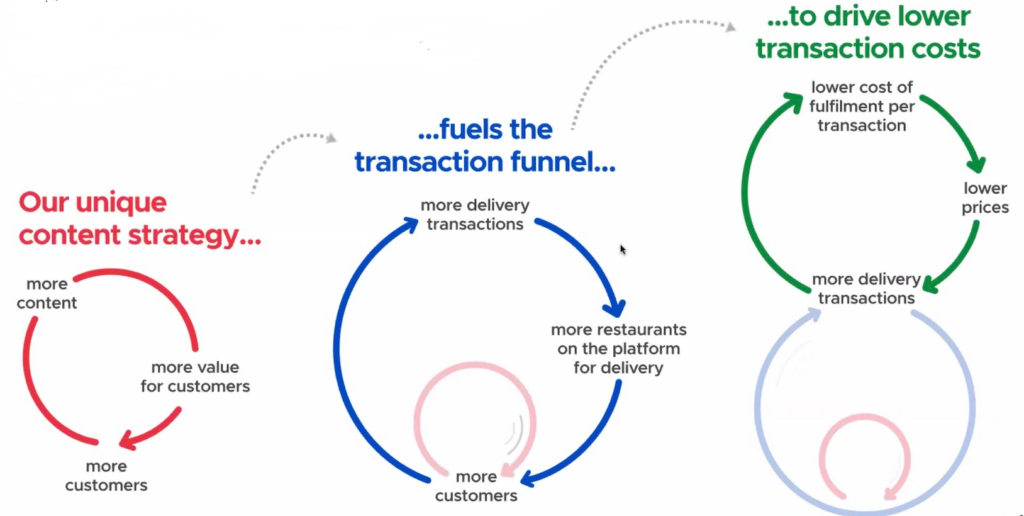Swiggy: From food-delivery to comprehensive urban convenience provider

Swiggy is transforming customer value creation and capture through an integrated multi-platform operating model.
What started as an on-demand food delivery platform in India in 2014, is well on its way to becoming the preferred urban dweller’s choice for comprehensive on-demand delivery. In January this year, Swiggy announced a $700 million investment in its quick commerce grocery service Instamart, making it a Decacorn! As it embarks on this new journey, it faces the twin challenge of ensuring user stickiness in an increasingly competitive food delivery market and fueling growth through its Instamart grocery delivery.
Swiggy – Story
Sriharsha Majety, Nandan Reddy and Rahul Jaimini cofounded Swiggy in 2014. Sriharsha and Nandan started Bundl Technologies, a logistics solution company connecting businesses to courier service providers, which failed. Later they onboarded Rahul as their CTO and their love for logistics prevailed when they started Swiggy which prides itself in running one of the most efficient hyperlocal logistics in India.

Today, Swiggy operates at a humungous scale across 500+ cities in India.

Key Value Proposition & revenue model
Swiggy’s earliest challenge in a market dominated by two major competitors in 2014 was winning over restaurants. Through data sciences and machine learning in areas with high demand and restaurant presence, they expanded their delivery partner capacities (with significant buffer) to deliver food in 30-40 minutes. Eventually, the network effects of a twin-sided market combined with a seamless UX on their mobile app, seamless 24×7 customer service, no minimum order policy, and integration with efficient digital payment apps fueled their exponential growth. Their revenue streams now include delivery charges, advertising, commissions from restaurants, and more recently, cloud kitchens.

Delivering value through AI
Apart from tracking on-app customer preferences about restaurants and dishes varying by space and time, Swiggy also uses a food intelligence platform that is constantly learning how to understand as much as one can about food to build it into user communication. On the delivery partner’s side, AI is used for tracking movements, order delivery patterns, delivery demand-supply matching, and forecasting, among others. The same is leveraged for restaurants and stores as well.
Transition to Quick Commerce
Swiggy started its Instamart in 2020 with a goal of leveraging its logistics and customer value delivery experience in food delivery. As its next stage growth driver, Swiggy has achieved the same level of gross merchandize value on Instamart in 17 months that its food delivery platform could achieve in 40 months. With a promise to delivery instant grocery in 15 minutes, Swiggy is eyeing a 100 million user base in the next 4-5 years.
To deliver this customer value, Swiggy utilizes location intelligence and demand density mapping to place its dark stores closer to the customer. These stores are seller-managed stores and deploy technological solutions to expedite pack and pick operations.
With more than 500 brands and 5000 products, Swiggy’s immediate priority is to increase cross-pollination between its existing food delivery user base and Instamart.
Increasing user stickiness & capturing value
Swiggy’s answer to reducing multihoming has been to run a cross-platform, customer loyalty program called Swiggy One. With Swiggy One, subscribers/members get free delivery on food orders from all restaurants up to 10 Kms which was earlier limited to a very few restaurants, free delivery on food orders above ₹149, and 30% extra off on food orders over and above regular offers, with no maximum limit. This strategy primarily highlights Swiggy’s ability to capture value from restaurants through its market power and transfer a part of it back to its customers to maintain the growth in its user base.
An even more interesting aspect of Swiggy One is that it offers unlimited free deliveries on Swiggy Instamart for grocery orders above ₹99, extra savings on 1000+ products, and flat 10% off on another Swiggy platform- Genie (peer-to-peer pickup and delivery service). And all this for a membership cost of ₹899 for 12 months which can be recovered within 3-4 weeks on average. Swiggy One allows a customer to track savings and visualize the time it took to recover their Swiggy One investment.
Conclusion
With growing competition in the food delivery platforms’ business, Swiggy’s venture into quick commerce together with its multi-platform customer loyalty programs is an interesting move to watch. The coming months will demonstrate how good a bet it was.


